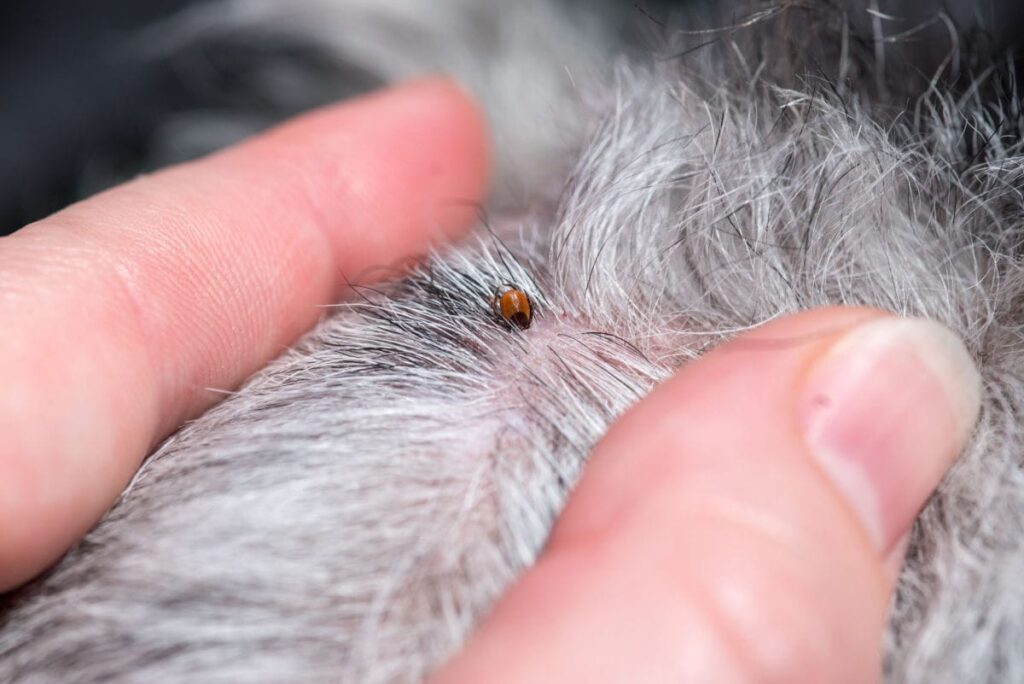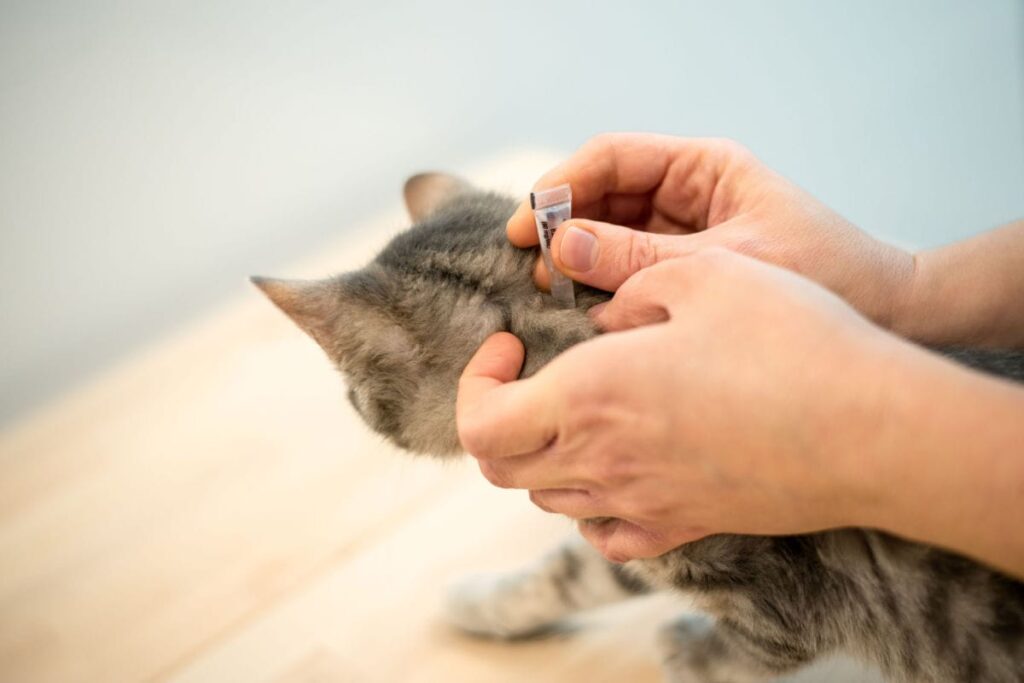Summer is tick season! Keep your cat healthy and learn how to remove a tick from a cat with our step-by-step guide.
Ticks are one of the few icky parts of the outdoors. These pesky little parasites latch on to warm-blooded beings, including cats and dogs, and feed off their blood. They typically get their fill over a few days and fall off cats and dogs on their own.
Unfortunately, ticks can carry diseases, bacteria, and viruses that are a risk to pets and humans—the most common being Lyme disease and ehrlichiosis.
Whether your fancy feline is an indoor homebody or an outdoor adventurer, they can still be susceptible to ticks tracked into the house accidentally by dogs or other family members. Removing ticks quickly is the best way to prevent the risk of disease if your kitty cat does get a tick bite.

Here’s What You’ll Need To Remove Ticks:
- A pair of tweezers or other tick removal tool
- Rubbing alcohol or other antiseptic
- Disposable gloves
- Antibiotic ointment
- Cat treats
- Small jar or container
Most pet shops carry special tweezers or tick removal tools, antibiotic ointment for pets, and other cat care items to keep on hand for removing ticks and other first aid needs.
Step-by-step Guide For Removing A Tick From A Cat:

Get your kitty as comfortable as possible, and in a position where they won’t take off if they feel a slight pinch. Now is the time to distract them with a cat treat!
- Use disposable gloves to prevent the spread of bacteria or possible disease
- Disinfect the tweezers using rubbing alcohol
- Push away as much of your cat’s fur as possible with your fingers
- Use the tweezers to grip the head of the tick against your cat’s skin
- Pull with a steady grip—don’t wiggle or twist since this can leave parts of the tick behind (if this happens, use the tweezers to remove any of the tick’s mouthparts)
- Once removed, place the tick in the container of rubbing alcohol
- Apply disinfectant and antibiotic ointment to the tick bite area on your pet’s skin
It’s important to make sure the whole tick is removed. Sometimes the body of the tick is removed, but the tick’s head remains latched into your cat’s body. If parts of the tick are left behind, it can actually survive and refill with blood.
Parts left behind can also become a risk of infection, so treating the area with disinfectant after you remove ticks is crucial.
Don’t dig with tweezers for parts of the tick that may remain, as this can cause further infection and discomfort for your kitty. Simply dab the area with alcohol and treat with antibiotic ointment as directed.
If You’re Using A Tick Removal Tool…
- Use disposable gloves
- Disinfect the tick removal tool with rubbing alcohol
- Push away as much fur as possible to see the area
- Hook the tool under the tick as close to your cat’s skin as possible
- Rotate the tool gently until the tick separates from your cat
- Place the tick in rubbing alcohol
How To Get Rid Of A Tick Once It’s Removed
Try not to squish the tick to death since doing this can transmit diseases it may be carrying.
The CDC’s recommendation for the best way to get rid of a tick after it’s been removed is to drop it in a small amount of rubbing alcohol to kill it. You can also place it in a sealed bag, wrap it in tape tightly, or flush it down the toilet.
Monitor Your Cat After Removing A Tick

Just like for humans, it’s important to monitor cats for signs of illness after a tick bite. Watch their body language and assess the bite area over the next few days to be sure it doesn’t become infected. It’s normal for there to be a little bit of redness and a scab where the tick bit your cat, but if the area becomes swollen seek your veterinarian’s opinion.
Signs Of Tick Borne Illness In Cats Can Include:
- Fever
- Loss of appetite
- Trouble walking
- Lethargy
- Pale gums
- Swelling of the tick bite area
Tick Prevention Methods For Cats

The best defense for cat owners and the health of your furry family members to avoid the risk of infection is to prevent bites when possible, and properly remove and treat tick bites when they do happen.
Use products formulated specifically for cats, as products made for other pets may contain components not safe for felines.
Here are a few ways to help prevent tick bites from getting to your cat in the first place:
Tick Collars
Tick collars can eliminate ticks and fleas that may have already made their way into your cat’s fur. They also work as a repellent to help protect your cat and prevent unwanted guests for up to eight months.
Most tick and flea collars are breakaway safe in case cats get caught up in something (we all know how curious they can be!).
Topical Tick Control
Topical tick control treatments are applied directly to your cat’s skin. One treatment option is tick preventing solution like Frontline that’s applied onto your cat’s shoulders so they can’t lick it off. Once dry, it can prevent ticks for around 30 days.
There are tick control sprays that offer both short-term and long-term protection and can kill fleas and ticks quickly after your cat has spent a day romping through the woods. Just be careful using the spray around their face.
Tick-control shampoos can be effective for cats who will tolerate a little time in the bathtub and may be necessary for those who have a flea or tick infestation on their hands, though they don’t have the same long-lasting effects as other topical treatments.
Oral Tick Control
Tick control pills vary in their effectiveness. Natural options exist but tend to have more short-term protection, and most prescription options will protect your cat from ticks for one to three months. Try using yummy cat treats to get your fur baby to take their pills.
Keeping your cat up to date on vaccinations and maintaining their overall health is an excellent form of preventative care should your sweet feline get a tick bite.
Types Of Ticks Found In The United States

Ticks live in tall grass and low shrubs and love warm, moist environments near forested areas with plenty of shade. Around homes, they can be found in laws, bushes, gardens, and woods.
There are nine main types of ticks in the United States that carry diseases transmittable to humans, and some to pets.
- American Dog Tick
- Blacklegged “Deer” Tick
- Brown Dog Tick
- Groundhog Tick
- Lone Star Tick
- Pacific Coast Tick
- Rocky Mountain Wood Tick
- Soft Ticks
- Western Blacklegged Tick

